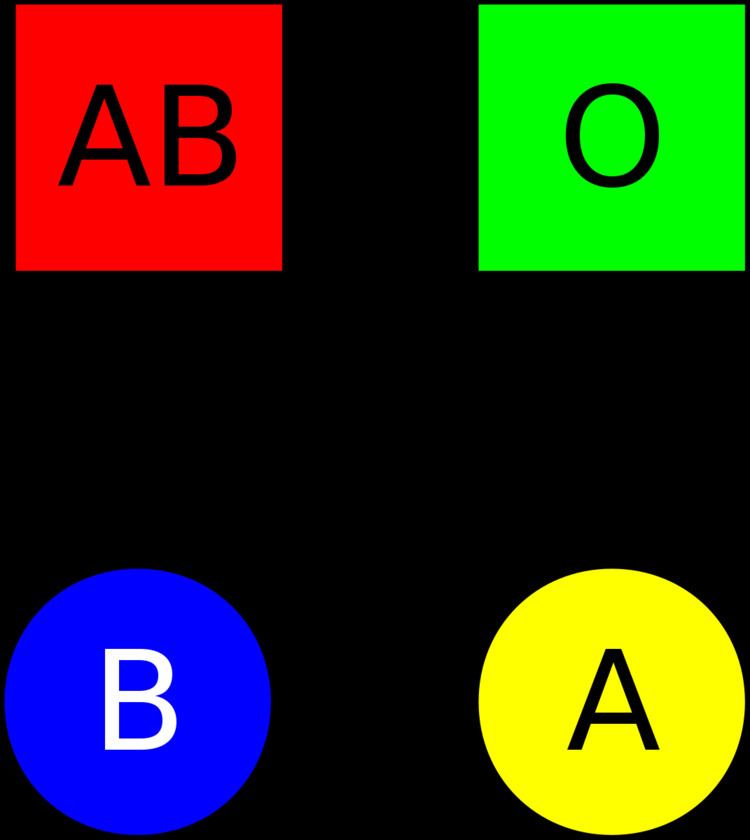 | ||
Cis AB is a rare mutation in the ABO gene which complicates the basic inheritance pattern and blood-transfusion compatibility matching for ABO blood typing. There are different DNA mutations of either type A or Type B alleles that change several amino acids in enzyme transferase A or B, homologous enzymes differing in only four of 354 amino acids (R176G, G235S, L266M, and G268A). A single change in ABO gene DNA could reverse type B to type A and then, a new hybrid enzyme will produce both weak B and A2 (in serum test, A2B and A2B3)). The most common mutation is an A105 allele variation in exon 7 nucleotide position G803C changing Glycine (type A) to Alanine (type B). There are another 8 alleles reported in BGMUT, the most discovered reciently in China and Taiwan. In the cis-AB genotype, both antigens are expressed, like in a standard (trans) AB genotype. In a traditional AB phenotype, A and B antigenes are inherited separately from the father and mother while a cis-AB allele comes from one parent only. In a serum test, cis-AB tests almost the same as a traditional AB, but people with this rare type have problems with blood transfusions. Some of them need components like washed red blood cells or autotransfusion of serum and blood. Cis-AB type was studied first in Japan (Shishoku Island) and South Korea (Gwanju area) where this rare type is more common (Chinese coast provinces and Taiwan, too), although it is also seen in a few European families (from France, Spain, Belgium, Germany, and Poland). In the year 2004, the American Red Cross described a family in Nebraska with a father of type cis-AB rh negative, a mother type O and their baby of type cis-AB. Since then, several cases in America have been reported. Antigen expression is weaker than A1 or B.
Contents
Scenarios
When one parent carries a Cis AB allele, the other allele can be any of O, A or B and the phenotype of this parent is always AB, but the children will inherit either the AB or the other allele from this parent.
- If the other parent is O phenotype (OO genotype) there are three possible scenarios for the blood group of children of a Cis AB carrier (and a 4th very unlikely scenario):
- The second allele is O: children are either AB or O
- Second allele is A: Children are either AB or A
- Second allele is B: Children are either AB or B
- A very rare 4th possibility exists: if the other allele is also Cis AB then the children will be always AB irrespective whatever the other parent is, because they will have one cis AB allele from this parent.
- If the other parent is type A, depending on whether this parent is genotypically AA or AO and what the other allele is in the Cis Ab carrying parent, the following scenarios are possible:
- Other parent is AO and second allele is O: The children are either AB or A or O
- Other parent is AA and the second allele is O: The children are either AB or A
- Other parent is AO and second allele is A: The children are either AB or A
- Other parent is AA and the second allele is A: The children are either AB or A
- Other parent is AO and the second allele is B: The children are either AB or B
- Other parent is AA and the second allele is B: The children are always AB
- Rare situation: If the other allele is also cis AB:The children are always AB
- Likewise, there will be similar scenarios for the other parent being type B:
- Other parent is BO and second allele is O: The children are either AB or B or O
- Other parent is BO and second allele is A: The children are either AB or A
- Other parent is BO and the second allele is B: The children are always AB or B
- Other parent is BB and the second allele is B: The children are either AB or B
- Other parent is BB and the second allele is O: The children are either AB or B
- Other parent is BB and the second allele is A: The children are always AB
- Rare situation: If the other allele is also cis AB:The children are always AB
(Caution: ABO inheritance is generally derived assuming the children are not the very rare Bombay phenotype which would require both parents to be carriers of it.)
Maternity and paternity disputes
When testing paternity or maternity by ABO blood group alone, it is possible to have a paradoxical result in the rare instance that a cis-AB genotype is involved. For example (scenario 1.1 above) a child of a cis AB individual (who will test as a regular AB phenotype) and an O individual will be either AB or O instead of the usual A or B (see diagram above).
Differential diagnosis
If the child of an AB and an O individual is O (the green colored offspring in the scenario 1 image above), then a rare alternative possibility is that the parents were carriers (heterozygous) for the Bombay phenotype (Hh) and the child is a Bombay (hh) homozygous by genotype thus expressing Bombay phenotype also called Oh where, regardless of the presence of the ABO alleles, the substrate from which those antigens are made is not made and thus A, B and even O antigen are not expressed at all and are completely absent from the red cells.
